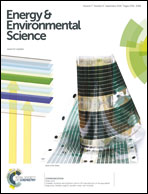A bio-photoelectrochemical cell with a MoS3-modified silicon nanowire photocathode for hydrogen and electricity production†
Abstract
Hydrogen production by solar energy conversion is an attractive and promising sustainable energy technology. Tremendous research effort has been directed towards the development and application of photoelectrochemical cells for hydrogen generation. Here, we report a novel bio-photoelectrochemical cell, which consists of a MoS3 modified p-type Si nanowire photocathode and a microbially catalyzed bioanode, for hydrogen production under visible light illumination. Microbial pollutant oxidation occurs spontaneously in the bioanode, which provides sufficient electrons for the photocathode reaction without external bias. The recombination of the photogenerated hole (hvb+) and electron (ecb−) pairs at the photocathode is retarded by the supply of electrons from the bioanode, leaving more available photogenerated electrons for hydrogen evolution reactions. As a result, the hydrogen production performance is improved. Under light illumination, hydrogen is continuously produced from the bio-photoelectrochemical cell, with a maximum power density of 71 mW m−2 and an average hydrogen-producing rate of 7.5 ± 0.3 μmol h−1 cm−2.


 Please wait while we load your content...
Please wait while we load your content...